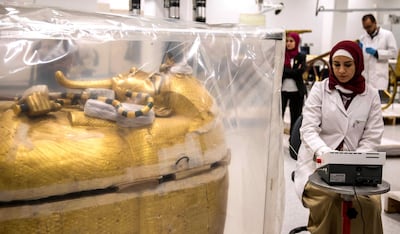Some of Greater Cairo’s busiest roads were closed to traffic on Friday to make way for an ancient Egyptian ship travelling from the Giza pyramids plateau to the Grand Egyptian Museum.
The 45-metre "solar barque" – a ritual vessel intended to carry the resurrected king across the skies – is believed to have been made for Pharaoh Khufu, also known by his Greek name Cheops.
It is set to be one of the soon-to-be-opened museum’s main exhibits. The ship was moved to its new home in an operation that lasted from Friday evening until Saturday morning, museum officials said.
Media outlets were not invited to witness the transfer, as it is was a precise and complicated process that would have been made more difficult by the presence of the press, said officials.
However, an unveiling ceremony will be held at a later date.
A remote-controlled vehicle on loan from Belgium carried the ship, which was transported without being dismantled. The smart vehicle took 10 hours to make the 7.5-kilometre journey from the Giza plateau to the Grand Egyptian Museum.
The procession moved at a slow pace to ensure the ship was not damaged, the museum’s general manager said.
The smart vehicle, which was unveiled by the Ministry of Tourism and Antiquities in June, is equipped with a mechanism that adapts to changes in the terrain, making it an apt choice for the uneven ground around the plateau.
Khufu’s ship is one of the oldest artefacts ever discovered in Egypt and the world, dating back to the Fourth Dynasty (2613 BC to 2494 BC) – one of the most powerful ruling families of the Old Kingdom.
Since 1982, the solar barque has been housed at a dedicated museum building by the Giza pyramids.
Preparing the ship to be moved was a long process that began 24 hours ahead of the transfer itself, the tourism ministry said on Saturday. The ship was safely encased within a capsule bearing its name in gold, which was then hoisted on to the massive Belgian vehicle.
The capsule was fitted with mechanisms to keep the ship stable and absorb any shock caused by uneven roads.

The ship was discovered in 1954 by one of Egypt’s most celebrated archaeologists, Kamal El Mallakh. It was found in a sealed pit by the Great Pyramid of Giza, the largest and most prominent pyramid on the Giza plateau, and the final resting place of its owner, Khufu.
Although the ship had fallen apart by the time it was unearthed, the wood was in a good condition as it was tightly sealed within a 52-metre chamber.
It reportedly took more than a decade to piece the vessel back together, and much of that time was spent studying shipbuilding customs of ancient Egypt.
Though the ship is believed to have been an important part of the pharaoh’s funerary rituals and meant to be used by him in the afterlife, there have been disagreements as to what its exact function was.
Evidence of water damage in its wood has made some researchers think that it could have been a prominent vessel in King Khufu’s fleet, one that he wanted to take with him to the afterlife.
The Grand Egyptian Museum is expected to open towards the end of the year. While no date has yet been announced, several reports indicate it could be in October or November.
The museum will display 50,000 artefacts, making it the largest archaeological museum in the world dedicated to a single civilisation. It covers an area of 480,000 square metres, overlooking the Giza plateau.

Some of ancient Egypt’s most illustrious relics will be displayed, including the famed collection of King Tutankhamen, which has been moved in its entirety to the museum’s halls after a world tour that saw it displayed in Paris, London and Los Angeles.
A number of artefacts will be shown for the first time, including a number of sarcophaguses uncovered last year. Other pieces have been moved from museums in a number of Egyptian provinces.








